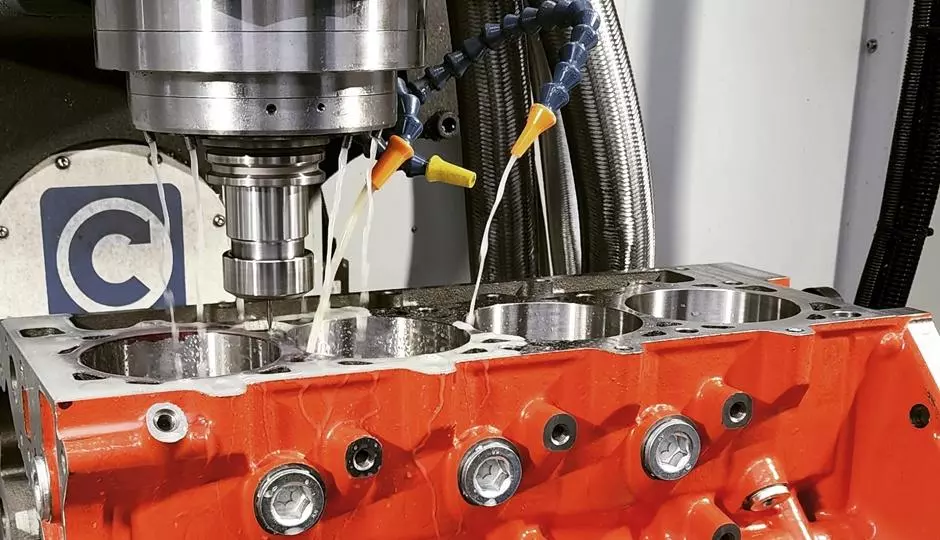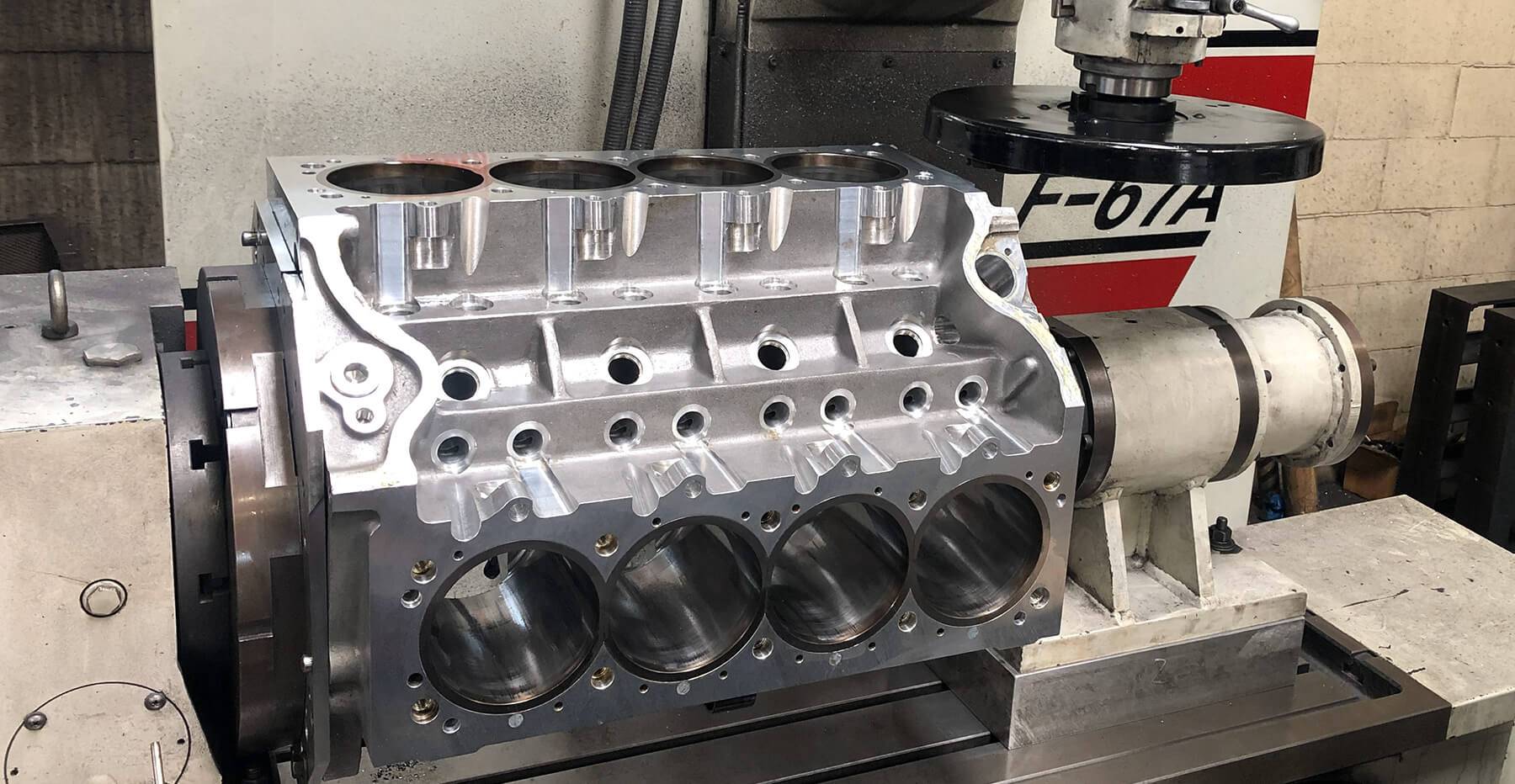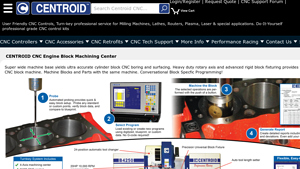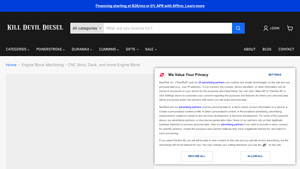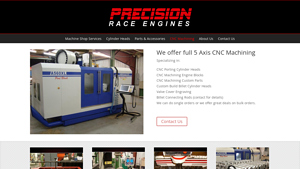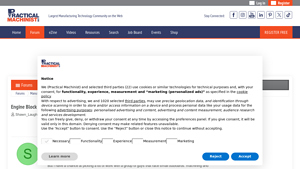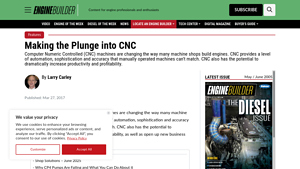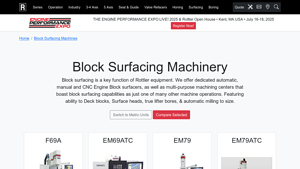Cnc Engine Block Machining Guide: Type, Cost, Top List…
Introduction: Navigating the Global Market for cnc engine block machining
In the rapidly evolving landscape of CNC engine block machining, international B2B buyers face the critical challenge of sourcing reliable suppliers that meet both quality and efficiency standards. As industries expand globally, particularly in regions such as Africa, South America, the Middle East, and Europe, the demand for precision-engineered components has surged. This guide is designed to empower you with actionable insights into the CNC engine block machining market, detailing various types of machining processes, their applications, and key factors to consider when vetting suppliers.
Throughout this comprehensive resource, you will discover essential information on the latest technologies in CNC machining, including automated blueprints and advanced surfacing techniques, which enhance production accuracy and speed. We will also explore cost considerations, quality assurance practices, and logistical challenges that international buyers may encounter. By leveraging the insights provided in this guide, you will be equipped to make informed purchasing decisions, ensuring that your sourcing strategies align with both operational needs and market trends. Whether you are a manufacturer in Brazil looking to upgrade your capabilities or a distributor in Vietnam seeking competitive suppliers, this guide serves as your roadmap to navigating the complexities of the CNC engine block machining market effectively.
Understanding cnc engine block machining Types and Variations
| Type Name | Key Distinguishing Features | Primary B2B Applications | Brief Pros & Cons for Buyers |
|---|---|---|---|
| CNC Blueprinting | Automated measurement and comparison to factory specs; easy-to-use conversational software | Engine rebuilding, performance tuning | Pros: High accuracy, speed; Cons: Initial setup cost |
| CNC Boring | Specialized tooling for precise diameter and angle adjustments; automatic setup features | High-performance engine assembly | Pros: Consistent quality; Cons: Limited to specific tasks |
| CNC Surfacing | Quick surface machining to exact specifications; smooth finishes for gasket performance | Racing engines, custom builds | Pros: Enhanced gasket sealing; Cons: Requires skilled operators |
| CNC Porting | 5-axis capabilities for intricate designs; enhances airflow and performance | Performance and racing applications | Pros: Increased power output; Cons: Complex programming |
| CNC Lightening | Material removal for weight reduction; custom tool paths based on block shape | Specialty racing applications | Pros: Improved performance; Cons: Risk of structural integrity loss |
What Are the Characteristics of CNC Blueprinting in Engine Block Machining?
CNC Blueprinting is a critical process in engine block machining that ensures precision by comparing actual measurements against factory specifications. This method utilizes advanced digitizing probes to automate the measurement of features such as cylinder bores and deck heights. B2B buyers should consider CNC blueprinting for applications requiring high accuracy and speed, particularly in engine rebuilding and performance tuning. While the initial setup costs may be higher, the long-term benefits of reduced labor and increased precision can justify the investment.
How Does CNC Boring Enhance Engine Performance?
CNC Boring focuses on refining cylinder bore dimensions to exact specifications, utilizing specialized tooling and automatic setup features. This type of machining is essential for high-performance engine assembly, where precision is paramount. B2B buyers in the automotive and motorsport sectors will find CNC boring indispensable for achieving consistent quality and performance. However, its application is somewhat limited to specific tasks, which may require additional investment in complementary machinery for a full suite of machining capabilities.
Why Is CNC Surfacing Important for Gasket Performance?
CNC Surfacing is designed to achieve precise surface finishes on engine blocks, which is vital for optimal gasket sealing. This process allows for quick adjustments to surface heights, ensuring a flat and square deck relative to the cylinder bore. B2B applications include racing engines and custom builds where high-performance reliability is critical. Although skilled operators are necessary to achieve the desired results, the enhanced gasket performance can significantly reduce the risk of engine failure in demanding applications.
What Benefits Does CNC Porting Offer for Racing Engines?
CNC Porting leverages 5-axis machining capabilities to create intricate designs that improve airflow through engine components, ultimately enhancing performance. This technique is particularly beneficial for racing applications where maximum power output is essential. B2B buyers should consider CNC porting for its ability to deliver significant performance gains, though the complexity of programming may require specialized training or expertise.
How Does CNC Lightening Contribute to Performance Optimization?
CNC Lightening involves the strategic removal of excess material from engine blocks to reduce weight, thereby improving overall performance. This method utilizes custom tool paths based on the block’s shape, ensuring that structural integrity is maintained while achieving weight reduction. B2B applications are prevalent in specialty racing contexts where every ounce counts. However, buyers must be cautious, as improper lightening can compromise the block’s strength, potentially leading to costly failures in high-stress environments.
Key Industrial Applications of cnc engine block machining
| Industry/Sector | Specific Application of cnc engine block machining | Value/Benefit for the Business | Key Sourcing Considerations for this Application |
|---|---|---|---|
| Automotive Manufacturing | Precision machining of engine blocks for performance vehicles | Enhanced engine performance and reliability | Supplier experience in high-performance applications |
| Heavy Machinery | Machining of engine blocks for construction equipment | Increased durability and operational efficiency | Availability of custom tooling for large components |
| Aerospace | Engine block machining for aircraft engines | Compliance with strict safety and performance regulations | Certification and quality assurance processes |
| Marine Engineering | Machining of engine blocks for ships and marine vessels | Improved fuel efficiency and lower emissions | Expertise in corrosion-resistant materials |
| Racing and Performance Tuning | High-precision CNC machining for race engines | Competitive advantage through optimized performance | Access to advanced CNC technologies and rapid prototyping |
How is CNC Engine Block Machining Used in Automotive Manufacturing?
In the automotive sector, CNC engine block machining is essential for producing high-performance engine blocks that meet stringent specifications. This process allows for precise boring, surfacing, and blueprinting, ensuring that each engine block is optimized for power and efficiency. Buyers in this sector should prioritize suppliers with experience in high-performance applications, as the demands for accuracy and reliability are critical. Additionally, having advanced software that simplifies programming and setup can significantly reduce production times.
What Role Does CNC Machining Play in Heavy Machinery?
CNC engine block machining is vital in the heavy machinery industry, where engine blocks must withstand extreme operational conditions. This machining process enhances the durability and efficiency of engines used in construction equipment, such as excavators and bulldozers. Buyers should consider suppliers who can provide custom tooling and machining capabilities tailored to large components. Additionally, understanding the specific requirements for material selection and heat treatment processes can lead to longer-lasting engine performance.
How is CNC Engine Block Machining Applied in Aerospace?
In aerospace, CNC engine block machining is crucial for fabricating components that meet rigorous safety and performance standards. The precision required in machining aircraft engine blocks ensures optimal performance and compliance with regulatory requirements. International buyers in this sector must seek suppliers with robust quality assurance processes and certifications, as even minor defects can have significant safety implications. Additionally, the ability to work with specialized materials that can withstand high temperatures and pressures is essential.
What Benefits Does CNC Machining Provide in Marine Engineering?
CNC engine block machining is increasingly important in marine engineering, particularly for the production of engine blocks in ships and marine vessels. This technology allows for the creation of components that enhance fuel efficiency and reduce emissions, aligning with global sustainability goals. Buyers should look for suppliers experienced in working with corrosion-resistant materials, as marine environments can be particularly harsh. Furthermore, the capability to produce custom designs that meet specific vessel requirements is a significant advantage.
How Does CNC Machining Enhance Racing and Performance Tuning?
In the racing industry, CNC engine block machining is leveraged to achieve maximum performance from race engines. This involves highly precise machining techniques that optimize airflow and reduce weight, providing a competitive edge on the track. Buyers in this niche market should focus on suppliers who offer advanced CNC technologies and rapid prototyping services to facilitate quick adjustments and enhancements. The ability to customize engine blocks for specific racing conditions is also crucial for success in this highly competitive field.
3 Common User Pain Points for ‘cnc engine block machining’ & Their Solutions
Scenario 1: Inaccurate Machining Leading to Rework
The Problem: In the competitive landscape of CNC engine block machining, precision is paramount. B2B buyers often face the issue of machines producing inaccurately machined components due to outdated technology or insufficient training. This not only results in wasted materials but also leads to costly delays and reputational damage, especially when customers expect rapid turnaround times. Furthermore, frequent rework can disrupt workflow, impacting overall productivity and profitability.
The Solution: To address this challenge, buyers should invest in modern CNC engine block machining centers equipped with advanced features such as automatic probing and digitizing technology. For instance, machines like the CENTROID CNC Block Machining Center offer automatic measurements of cylinder bores and deck heights, ensuring that all adjustments are based on precise data. Buyers should also prioritize training programs for their operators, focusing on the machine’s software capabilities. By utilizing conversational programming, operators can easily adjust specifications without needing extensive G-code knowledge, reducing the chances of human error. Implementing a routine maintenance schedule for the machinery will also help maintain accuracy over time, ensuring consistent production quality.
Scenario 2: Long Setup Times Hampering Efficiency
The Problem: A common pain point in CNC machining is the lengthy setup times associated with changing jobs. For engine rebuilders and performance shops, this can be a significant bottleneck, leading to lost revenue opportunities and an inability to meet tight deadlines. The frustration of having to wait for tools to be set up or recalibrated can lead to decreased morale among staff and dissatisfaction among customers.
The Solution: To mitigate long setup times, businesses should consider investing in CNC machines with features like automatic tool changers (ATCs) and tool path optimization software. Machines with a 24-tool ATC, for example, allow for quick transitions between different machining tasks without the need for manual tool changes. Additionally, adopting software solutions that enable the storage and retrieval of previous job settings can drastically reduce setup times for recurring tasks. Buyers should also encourage a culture of continuous improvement, where staff regularly assess and refine setup processes to identify inefficiencies. This proactive approach not only enhances operational efficiency but also ensures that the business remains competitive in a demanding market.
Scenario 3: Difficulty in Adapting to Diverse Engine Types
The Problem: As the automotive market evolves, buyers face the challenge of adapting CNC machining processes to cater to a wider variety of engine types, including high-performance and electric vehicles. Many existing CNC setups may lack the versatility needed to handle different specifications, leading to constraints in service offerings. This limitation can hinder business growth and prevent shops from tapping into lucrative new markets.
The Solution: To overcome this adaptability challenge, buyers should look for CNC machining centers that offer modular capabilities and extensive tooling options. For example, machines that support both standard and specialized tooling can seamlessly transition between different engine types. Additionally, investing in training for staff on the latest industry trends and machining techniques will empower them to handle diverse projects more effectively. Collaborating with suppliers to stay informed about advancements in CNC technology can also provide insights into future-proofing operations. Lastly, developing a flexible machining strategy that includes regular assessments of market demands will help businesses adjust their offerings proactively, ensuring they remain competitive in a rapidly changing landscape.
Strategic Material Selection Guide for cnc engine block machining
When selecting materials for CNC engine block machining, it is crucial to consider the specific properties and performance characteristics that align with the intended application. Here, we analyze four common materials used in this sector: Aluminum, Cast Iron, Steel, and Composite Materials. Each material has unique properties, advantages, and limitations that can significantly impact the machining process and the final product.
What Are the Key Properties of Aluminum in CNC Engine Block Machining?
Aluminum is a lightweight material known for its excellent thermal conductivity and corrosion resistance. It typically has a temperature rating of around 200°C and can withstand moderate pressure levels. The key advantage of aluminum is its ability to be machined easily, allowing for intricate designs and complex geometries. However, its lower strength compared to other materials can be a limitation, especially in high-performance applications. For international buyers, aluminum compliance with standards like ASTM B221 is essential, particularly in regions with stringent quality regulations.
How Does Cast Iron Perform in CNC Engine Block Machining?
Cast Iron is renowned for its durability and excellent wear resistance. It can handle high temperatures and pressures, making it suitable for heavy-duty applications. The material’s inherent damping properties also reduce vibrations during machining, leading to improved surface finishes. However, cast iron is relatively heavy and can be more challenging to machine due to its brittleness. Buyers in Africa and South America should consider the availability of cast iron grades that meet local standards such as ASTM A48 or DIN 1691, as these can influence both cost and quality.
What Are the Advantages and Disadvantages of Using Steel?
Steel is a versatile material that offers high strength and toughness, making it suitable for high-performance engine blocks. Its temperature and pressure ratings can vary significantly based on the alloy used, with some high-strength steels capable of withstanding extreme conditions. The primary disadvantage of steel is its weight, which can affect overall engine performance. Additionally, machining steel can be more complex due to its hardness. International buyers must be aware of the specific steel grades, such as JIS G3101 or ASTM A36, to ensure compliance with regional standards and preferences.
How Do Composite Materials Impact CNC Engine Block Machining?
Composite materials, such as carbon fiber reinforced polymers, are gaining traction in CNC engine block machining due to their lightweight and high-strength characteristics. They offer excellent resistance to corrosion and thermal expansion, making them suitable for high-performance applications. However, the primary limitation is the complexity of machining composites, which often requires specialized tools and techniques. Buyers in Europe and the Middle East should be aware of the specific regulations surrounding composite materials, including compliance with standards like ISO 13020, to ensure quality and performance.
| Material | Typical Use Case for cnc engine block machining | Key Advantage | Key Disadvantage/Limitation | Relative Cost (Low/Med/High) |
|---|---|---|---|---|
| Aluminum | Lightweight engine blocks for racing applications | Excellent thermal conductivity | Lower strength compared to steel | Medium |
| Cast Iron | Heavy-duty engine blocks for trucks and machinery | High durability and wear resistance | Brittle and heavy | Low |
| Steel | High-performance engine blocks for sports cars | High strength and toughness | More complex machining | High |
| Composite Materials | High-performance racing engines and lightweight applications | Lightweight and corrosion-resistant | Complex machining requirements | High |
In summary, selecting the right material for CNC engine block machining involves a careful evaluation of the material properties, advantages, and limitations, as well as compliance with regional standards. By understanding these factors, international B2B buyers can make informed decisions that align with their specific needs and applications.
In-depth Look: Manufacturing Processes and Quality Assurance for cnc engine block machining
What Are the Key Manufacturing Processes in CNC Engine Block Machining?
CNC engine block machining involves a series of meticulous manufacturing processes designed to ensure precision and quality. Understanding these stages is crucial for B2B buyers seeking reliable suppliers capable of meeting rigorous industry standards.
How Is Material Prepared for CNC Engine Block Machining?
The manufacturing process begins with material selection, typically aluminum or cast iron, known for their excellent thermal properties and strength. The selected material is then prepared through cutting or casting to create a rough shape of the engine block. This initial stage may involve:
- Cutting: Large metal sheets or blocks are cut to size using saws or plasma cutters.
- Casting: In some cases, molten metal is poured into molds to create the basic block shape.
Once the material is shaped, it undergoes a cleaning process to remove any contaminants or debris, ensuring a clean surface for subsequent machining.
What Forming Techniques Are Used in CNC Engine Block Machining?
After material preparation, the machining process begins. This involves several key operations:
- CNC Machining: Utilizing computer numerical control (CNC) machines, manufacturers execute precise cuts and shapes. CNC milling and turning are common techniques for creating the complex geometries found in engine blocks.
- Boring and Surfacing: These operations ensure that the cylinder bores and surfaces are perfectly aligned and flat. Advanced CNC machines equipped with probing systems measure and adjust the dimensions automatically, enhancing accuracy.
- Drilling and Tapping: For features such as head studs and lifter bores, CNC machines drill and tap holes with high precision, ensuring the correct diameter and location.
These processes are often interlinked, allowing for multiple operations to be performed on the same machine setup, reducing handling time and potential errors.
How Is Assembly Conducted in CNC Engine Block Machining?
Assembly in CNC engine block machining is generally minimal, as the block is typically a single component. However, for specialized applications, it may involve:
- Integrating Additional Components: This may include installing sleeves, fittings, or other features that enhance the block’s functionality.
- Final Adjustments: After machining, the block may require additional adjustments or modifications based on specific customer requirements or performance standards.
What Finishing Techniques Enhance the Quality of CNC Engine Blocks?
Finishing processes are critical for ensuring the engine block meets performance and aesthetic standards. Common techniques include:
- Deburring: Removing sharp edges and burrs left from machining to prevent assembly issues and enhance safety.
- Surface Treatment: Processes such as anodizing or painting may be applied to improve corrosion resistance and aesthetics.
- Quality Inspection: A thorough inspection follows finishing to verify that all dimensions and surface qualities meet the specified tolerances.
What Quality Control Measures Are Essential for CNC Engine Block Machining?
Quality assurance (QA) is vital in the CNC engine block machining process to ensure that the products meet international standards and customer expectations.
Which International and Industry-Specific Standards Should Buyers Be Aware Of?
B2B buyers should familiarize themselves with key international standards, such as:
- ISO 9001: This quality management standard ensures that manufacturers maintain consistent quality and are continuously improving processes.
- CE Marking: Particularly relevant for products sold in the European Union, it indicates conformity with health, safety, and environmental protection standards.
- API Standards: For those in the oil and gas industry, American Petroleum Institute standards are crucial for ensuring compatibility and safety in engine applications.
Understanding these standards helps buyers assess the credibility and reliability of potential suppliers.
What Are the QC Checkpoints in CNC Engine Block Machining?
Quality control checkpoints are critical throughout the manufacturing process. Common checkpoints include:
- Incoming Quality Control (IQC): Inspecting raw materials upon receipt to ensure they meet specifications.
- In-Process Quality Control (IPQC): Continuous monitoring during the manufacturing process to catch defects early.
- Final Quality Control (FQC): A comprehensive inspection of the finished product to ensure it meets all design and quality specifications.
Each checkpoint serves as a safeguard against defects, ensuring that only quality products are delivered.
What Common Testing Methods Are Utilized in Quality Control?
Manufacturers employ various testing methods to ensure the quality of CNC engine blocks, including:
- Dimensional Inspection: Using calipers, micrometers, and coordinate measuring machines (CMM) to verify that dimensions are within specified tolerances.
- Non-Destructive Testing (NDT): Techniques such as ultrasonic testing and dye penetrant inspection help detect internal flaws without damaging the component.
- Performance Testing: Engine blocks may undergo performance tests to assess their functionality under simulated operating conditions.
How Can B2B Buyers Verify Supplier Quality Control?
To ensure they partner with reliable manufacturers, B2B buyers should implement several verification strategies:
What Steps Can Buyers Take to Conduct Supplier Audits?
- Supplier Audits: Regular audits of suppliers can provide insights into their manufacturing processes, quality control measures, and compliance with international standards.
- Request Quality Assurance Reports: Suppliers should provide documentation demonstrating their adherence to quality standards and the results of inspections and tests.
- Third-Party Inspections: Engaging independent inspectors can provide an unbiased evaluation of the supplier’s quality control processes and product quality.
What QC and Certification Nuances Should International Buyers Consider?
International buyers must be aware of specific nuances when dealing with suppliers from different regions, particularly in Africa, South America, the Middle East, and Europe:
- Cultural Differences: Understanding local business practices and communication styles can enhance collaboration and ensure smoother transactions.
- Regulatory Compliance: Different regions may have specific regulatory requirements that must be met, necessitating thorough research and verification.
- Trade Agreements: Familiarity with international trade agreements can help buyers navigate tariffs and import/export regulations, ensuring compliance and cost-effectiveness.
By understanding these manufacturing processes and quality assurance measures, B2B buyers can make informed decisions when selecting suppliers for CNC engine block machining. This knowledge not only aids in ensuring product quality but also fosters long-term, successful partnerships in the global marketplace.
Practical Sourcing Guide: A Step-by-Step Checklist for ‘cnc engine block machining’
This practical sourcing guide aims to provide international B2B buyers with a comprehensive checklist for procuring CNC engine block machining services. It highlights critical steps to ensure that you select the right suppliers and achieve the best outcomes for your machining needs.
Step 1: Define Your Technical Specifications
Establishing clear technical specifications is crucial for guiding your sourcing process. Detail the required machining operations, tolerances, and materials needed for your engine blocks. This clarity helps suppliers understand your needs and ensures they can meet your expectations.
- Considerations: Identify specific features such as boring, surfacing, and lifter bore machining.
- Documentation: Create a detailed document that outlines your requirements, including any industry standards you must adhere to.
Step 2: Research Potential Suppliers
Conduct thorough research to identify potential suppliers that specialize in CNC engine block machining. Look for companies with a solid track record in the industry and positive reviews from past clients.
- Resources: Utilize online platforms, industry publications, and trade shows to gather information.
- Geographical Focus: Pay attention to suppliers in your target regions, such as Africa, South America, the Middle East, and Europe, to mitigate logistical challenges.
Step 3: Evaluate Supplier Capabilities
Before committing to a supplier, assess their machining capabilities. Ensure they have the necessary machinery, technology, and expertise to handle your specific requirements.
- Key Questions: Inquire about their CNC machine types, tooling options, and whether they provide additional services such as blueprinting.
- Visit Facilities: If possible, visit the supplier’s facility to inspect their equipment and processes firsthand.
Step 4: Verify Supplier Certifications
Ensure that your chosen suppliers hold relevant certifications and comply with industry standards. This verification is essential for quality assurance and can prevent costly mistakes down the line.
- Common Certifications: Look for ISO 9001 or similar quality management certifications.
- Regulatory Compliance: Confirm that the supplier adheres to local and international regulations pertinent to engine block machining.
Step 5: Request Quotes and Compare Pricing
Once you have narrowed down your options, request detailed quotes from multiple suppliers. Comparing prices helps you understand the market rate and identify any discrepancies.
- Quote Components: Ensure that quotes include all costs, such as setup fees, tooling, and any potential additional charges.
- Value vs. Cost: Focus on the value offered rather than just the lowest price; consider factors like lead times and customer support.
Step 6: Check References and Past Work
Reach out to previous clients of the suppliers to gain insights into their reliability and quality of work. This step can reveal potential red flags and help you make a more informed decision.
- Questions to Ask: Inquire about the quality of the machining work, adherence to deadlines, and overall satisfaction with the service.
- Case Studies: Request case studies or examples of similar projects they have successfully completed.
Step 7: Establish Clear Communication Channels
Finally, ensure that there are clear lines of communication established with your chosen supplier. Effective communication is key to successful project execution and can help resolve any issues that arise.
- Communication Methods: Specify preferred methods of communication, such as email, phone, or project management tools.
- Regular Updates: Agree on regular updates and checkpoints throughout the machining process to ensure alignment and address any concerns promptly.
By following this checklist, B2B buyers can effectively navigate the sourcing process for CNC engine block machining, ensuring that they select the right suppliers to meet their technical and operational needs.
Comprehensive Cost and Pricing Analysis for cnc engine block machining Sourcing
What Are the Key Cost Components in CNC Engine Block Machining?
Understanding the cost structure is vital for international B2B buyers considering CNC engine block machining. The primary components include:
-
Materials: The choice of materials significantly impacts the cost. High-quality metals such as aluminum or cast iron are commonly used, and fluctuations in raw material prices can affect overall expenses. Buyers should consider sourcing materials locally to mitigate costs.
-
Labor: Skilled labor is essential for CNC machining. Labor costs vary widely depending on the region and the complexity of the machining process. In regions like Africa and South America, labor may be more cost-effective, but it’s crucial to ensure that workers possess the necessary expertise.
-
Manufacturing Overhead: This encompasses expenses related to facility operations, utilities, and administrative costs. Efficient manufacturing processes can help reduce overhead costs, making it essential for buyers to evaluate suppliers’ operational efficiencies.
-
Tooling: Specialized tooling for CNC machines can be a significant investment. The cost varies based on the complexity of the engine blocks being machined. Buyers should inquire about tooling life and replacement costs to better understand long-term expenses.
-
Quality Control (QC): Rigorous QC processes are essential to ensure precision in engine block machining. Investing in quality assurance can prevent costly reworks and defects, ultimately impacting the total cost of ownership.
-
Logistics: Shipping costs can vary significantly depending on the distance and method of transport. For international buyers, understanding Incoterms is crucial to manage logistics costs effectively.
-
Margin: Suppliers typically add a margin to cover their costs and generate profit. This margin can fluctuate based on market demand and competition, making it important for buyers to shop around for the best pricing.
How Do Pricing Influencers Impact CNC Engine Block Machining Costs?
Several factors influence pricing in CNC engine block machining:
-
Volume/MOQ: Suppliers often offer better rates for bulk orders or higher Minimum Order Quantities (MOQs). Buyers should assess their production needs to leverage volume discounts effectively.
-
Specifications and Customization: Custom-engineered solutions may incur additional costs due to unique tooling and labor requirements. Clear communication of specifications can help avoid unexpected expenses.
-
Materials and Quality Certifications: The choice of materials directly affects pricing, especially if specific quality certifications are required. Suppliers with high-quality standards may charge more but can provide value through durability and performance.
-
Supplier Factors: Supplier reputation, experience, and location can influence pricing. Established suppliers may command higher prices due to their reliability and superior service.
-
Incoterms: Understanding the agreed-upon Incoterms can help buyers manage shipping responsibilities and costs. This is particularly important for international transactions to avoid hidden fees.
What Are the Best Buyer Tips for Cost-Efficiency in CNC Engine Block Machining?
International B2B buyers should consider the following strategies to enhance cost-efficiency:
-
Negotiation: Engage in open discussions with suppliers about pricing and payment terms. Long-term relationships can often lead to better pricing and service agreements.
-
Total Cost of Ownership (TCO): Look beyond initial pricing. Consider maintenance, tooling replacement, and logistics in the TCO analysis to make informed decisions.
-
Pricing Nuances for International Buyers: Be aware of currency fluctuations, tariffs, and trade regulations that can impact costs when sourcing from different regions like Africa, South America, the Middle East, and Europe.
-
Supplier Audits: Conducting supplier audits can provide insights into their operational efficiencies, helping to identify potential cost-saving opportunities.
Disclaimer on Indicative Prices
Prices for CNC engine block machining can vary widely based on the factors mentioned above. Buyers should request detailed quotes from multiple suppliers to obtain a clearer understanding of potential costs. Always consider regional economic conditions and market trends when evaluating pricing.
Alternatives Analysis: Comparing cnc engine block machining With Other Solutions
Understanding Alternatives to CNC Engine Block Machining
When considering the best solution for engine block machining, it is essential to evaluate various technologies and methods that can meet specific operational needs. CNC engine block machining offers precision and efficiency, but there are alternative methods available that may align better with certain business requirements, particularly in diverse markets across Africa, South America, the Middle East, and Europe. This analysis will compare CNC engine block machining with two viable alternatives: manual machining and additive manufacturing.
Comparison Table
| Comparison Aspect | Cnc Engine Block Machining | Manual Machining | Additive Manufacturing |
|---|---|---|---|
| Performance | High precision and repeatability | Variable, depends on skill level | High precision for complex designs |
| Cost | Higher initial investment, lower long-term costs | Lower initial cost, higher labor costs | Medium initial cost, material costs vary |
| Ease of Implementation | Requires training and setup | Minimal setup, requires skilled labor | Requires specialized equipment and training |
| Maintenance | Moderate, requires regular servicing | High, as tools wear quickly | Low, equipment is less subject to wear |
| Best Use Case | High-volume production, precision work | Custom, low-volume jobs | Complex geometries and prototypes |
Detailed Breakdown of Alternatives
Manual Machining
Manual machining involves the use of traditional tools such as lathes and milling machines operated by skilled laborers. While this method can be cost-effective for small-scale operations or custom jobs, its performance can vary significantly based on the operator’s skill level. Manual machining allows for flexibility and creativity in custom projects, but it often leads to longer production times and less consistency in quality compared to CNC machining. For businesses focused on bespoke solutions or low-volume jobs, manual machining may be the preferred option.
Additive Manufacturing
Additive manufacturing, commonly known as 3D printing, is an innovative alternative that builds parts layer by layer. This technology excels in creating complex geometries that traditional machining methods cannot easily achieve. The initial investment in additive manufacturing can be moderate, and while material costs can vary widely, it offers the potential for rapid prototyping and reduced waste. However, the speed of production for large parts may not yet match that of CNC machining, and the technology may require specialized training. Businesses aiming to produce intricate designs or prototypes could benefit from this approach.
Conclusion: How to Choose the Right Solution for Engine Block Machining
When selecting the appropriate machining method, B2B buyers should assess their specific needs, including production volume, budget constraints, and desired precision. CNC engine block machining is ideal for high-volume production requiring precision and efficiency, while manual machining may suit custom projects with lower production demands. On the other hand, additive manufacturing presents unique advantages for complex designs and rapid prototyping. By carefully evaluating these alternatives against their operational requirements, businesses can make informed decisions that enhance productivity and profitability.
Essential Technical Properties and Trade Terminology for cnc engine block machining
What Are the Key Technical Properties in CNC Engine Block Machining?
-
Material Grade
The material grade of an engine block significantly influences its performance and durability. Common materials include aluminum alloys and cast iron, each offering unique benefits. Aluminum is lightweight and excellent for heat dissipation, while cast iron provides superior strength and wear resistance. For B2B buyers, understanding material properties is critical for ensuring the selected engine block meets specific performance requirements, especially in high-stress applications. -
Tolerance
Tolerance refers to the allowable variation in dimensions during the machining process. In CNC engine block machining, tight tolerances (typically ±0.001 inches or better) are essential for ensuring proper fit and function of engine components. For buyers, precise tolerances lead to improved engine performance and longevity, reducing the risk of costly failures and rework. -
Surface Finish
The surface finish of machined components affects friction, wear, and sealing capabilities. Common surface finish specifications are measured in Ra (roughness average) values, where lower values indicate smoother surfaces. A quality surface finish is crucial for optimal gasket sealing and overall engine efficiency. Buyers should prioritize suppliers who can consistently achieve the required surface finish standards for their applications. -
Machining Speed and Feed Rate
Machining speed (the rate at which the tool moves through the material) and feed rate (the speed at which the material is fed into the tool) are critical parameters that affect production efficiency and quality. Optimizing these parameters can lead to faster cycle times and reduced tool wear. For B2B buyers, understanding these metrics allows for better project planning and cost estimation. -
Fixture Design
Proper fixture design is vital for securing the engine block during machining operations. A well-engineered fixture minimizes movement and vibration, ensuring accuracy and repeatability. For businesses, investing in advanced fixture designs can lead to improved machining outcomes and lower operational costs over time. -
Tooling Type
The type of tooling used in CNC machining, such as drills, end mills, and specialized cutting tools, directly impacts the efficiency and quality of the machining process. Tooling must be selected based on the specific material and machining operation. Buyers should evaluate suppliers based on their tooling capabilities and expertise to ensure they can meet project demands effectively.
What Are Common Trade Terms Used in CNC Engine Block Machining?
-
OEM (Original Equipment Manufacturer)
OEM refers to companies that produce parts that are used in the assembly of another company’s product. In the context of CNC engine block machining, OEMs often require high-quality machining services to create engine blocks that meet their strict specifications. Understanding OEM requirements can help buyers identify suitable machining partners. -
MOQ (Minimum Order Quantity)
MOQ is the smallest quantity of a product that a supplier is willing to sell. In CNC machining, MOQs can vary based on the complexity of the machining process and the type of materials used. Buyers should be aware of MOQs to ensure they can meet their production needs without incurring excessive costs. -
RFQ (Request for Quotation)
An RFQ is a document sent to suppliers requesting pricing and details for specific services or products. In CNC engine block machining, RFQs help buyers gather information on costs, lead times, and capabilities from multiple suppliers, facilitating informed decision-making. -
Incoterms (International Commercial Terms)
Incoterms are internationally recognized terms that define the responsibilities of buyers and sellers in shipping and delivery. Understanding these terms is essential for B2B buyers to manage logistics effectively and mitigate risks associated with international transactions. -
CNC (Computer Numerical Control)
CNC refers to the automated control of machining tools via computer programming. This technology allows for high precision and repeatability in manufacturing processes, making it a cornerstone of modern engine block machining. Buyers should look for suppliers that utilize advanced CNC technology to ensure quality and efficiency. -
TQM (Total Quality Management)
TQM is a management approach focused on continuous improvement of processes, products, and services. In the CNC engine block machining industry, TQM ensures that all aspects of production meet quality standards, leading to enhanced customer satisfaction. Buyers should seek partners committed to TQM principles for consistent quality outcomes.
Understanding these technical properties and trade terms can empower B2B buyers to make informed decisions in the CNC engine block machining sector, ultimately leading to better product performance and business success.
Navigating Market Dynamics and Sourcing Trends in the cnc engine block machining Sector
What Are the Current Market Dynamics and Key Trends in CNC Engine Block Machining?
The CNC engine block machining sector is experiencing significant transformation driven by global market forces and technological advancements. Key drivers include the increasing demand for high-performance engines in motorsports and automotive applications, particularly in emerging markets such as Africa, South America, and Southeast Asia. The proliferation of electric vehicles (EVs) and hybrid technologies is also influencing traditional machining processes, pushing manufacturers to innovate and adapt.
Emerging trends in B2B technology include the adoption of advanced CNC machining centers that integrate automation, robotics, and AI. These technologies enhance precision and efficiency, reducing lead times and labor costs. For international buyers, particularly from developing regions, investing in such technologies can facilitate competitive advantages by improving operational efficiency and quality control. Additionally, the growing importance of data analytics in monitoring machining processes allows for real-time adjustments and predictive maintenance, further optimizing production.
Market dynamics are also shaped by the increasing globalization of supply chains. B2B buyers must navigate fluctuating material costs and availability, often influenced by geopolitical factors. As a result, sourcing strategies need to be flexible, with an emphasis on building strong relationships with suppliers across different regions. This adaptability is crucial for managing risks associated with supply chain disruptions, ensuring that companies can meet the rising demands of their customers effectively.
How Can Sustainability and Ethical Sourcing Influence CNC Engine Block Machining?
Sustainability has become a critical focus in the CNC engine block machining sector, with environmental impacts gaining scrutiny from consumers and regulatory bodies alike. The machining process can generate significant waste and emissions, prompting manufacturers to adopt greener practices. This includes optimizing machining parameters to minimize scrap and employing energy-efficient machinery that reduces carbon footprints.
Ethical sourcing is equally important, as B2B buyers increasingly prefer suppliers who demonstrate commitment to sustainable practices. This encompasses not only the use of eco-friendly materials but also the establishment of transparent supply chains that uphold labor rights and environmental standards. Certifications such as ISO 14001 for environmental management and adherence to the United Nations Global Compact can enhance a company’s reputation and appeal to conscientious buyers.
Moreover, the shift towards using recyclable materials in machining processes is gaining traction. By integrating sustainable materials, manufacturers can reduce their ecological impact while meeting the growing market demand for environmentally responsible products. This not only positions companies favorably in the eyes of clients but also aligns with global sustainability goals.
What is the Evolution and Historical Context of CNC Engine Block Machining?
CNC engine block machining has evolved significantly since its inception in the mid-20th century. Initially, engine blocks were machined using manual processes, which were time-consuming and prone to human error. The introduction of CNC technology revolutionized this sector, allowing for higher precision, repeatability, and efficiency in machining operations.
As automotive engineering advanced, the need for more complex engine designs emerged, driving the demand for sophisticated CNC machines capable of handling intricate geometries. Over the years, innovations such as 5-axis machining and automated tooling systems have further enhanced productivity and accuracy, making CNC machining an indispensable part of modern engine manufacturing.
Today, the sector continues to evolve, with a strong focus on integrating smart technologies and sustainable practices, ensuring that CNC engine block machining remains at the forefront of the automotive industry. This historical context provides valuable insights for B2B buyers, highlighting the importance of staying abreast of technological advancements and market trends to remain competitive in this dynamic landscape.
Frequently Asked Questions (FAQs) for B2B Buyers of cnc engine block machining
-
How do I choose the right CNC engine block machining supplier?
Choosing the right supplier involves evaluating their technical capabilities, quality assurance processes, and industry experience. Verify their machinery, such as the latest CNC technologies, and assess their ability to handle your specific machining needs, such as blueprinting and surfacing. Request client testimonials and case studies to gauge their reliability. Furthermore, consider their compliance with international standards and certifications, which can be crucial for ensuring quality and consistency in your orders. -
What are the common customization options available in CNC engine block machining?
Customization options can vary widely among suppliers but typically include tailored machining processes for specific engine types, adjustments in tolerances, and surface finishes. Many suppliers offer services like CNC block lightening, O-ring grooving, and lifter bore machining, enabling you to optimize performance for your applications. Engage in discussions with potential suppliers to clarify how they can accommodate your unique specifications and any additional tooling or programming they might offer. -
What is the minimum order quantity (MOQ) for CNC engine block machining?
MOQs can differ significantly based on the supplier and the complexity of the machining process. Some suppliers may have flexible MOQs for initial orders, especially for international buyers looking to establish long-term partnerships. It’s advisable to communicate your needs directly with suppliers to negotiate terms that suit your operational requirements, ensuring you can manage inventory effectively without excessive upfront investment. -
How do I ensure quality assurance in CNC engine block machining?
To ensure quality assurance, look for suppliers that implement rigorous quality control measures, such as in-process inspections, final product testing, and adherence to international quality standards (e.g., ISO 9001). Request documentation of their quality assurance processes and any relevant certifications. Additionally, consider setting up a trial run or pilot project to assess their capabilities before committing to larger orders. -
What payment terms should I expect when sourcing CNC engine block machining internationally?
Payment terms can vary by supplier and region but typically include options such as advance payment, letters of credit, or net payment terms after delivery. Discuss payment options upfront to ensure they align with your financial strategies. It’s also wise to consider the currency exchange implications and any potential fees associated with international transactions, which can affect overall costs. -
What are the logistics considerations for importing CNC engine block machining services?
Logistics considerations include shipping methods, customs regulations, and delivery times. When sourcing internationally, ensure that the supplier has experience with export processes and can provide all necessary documentation for customs clearance. Factor in shipping costs and transit times when planning your production schedules. Collaborate with reliable freight forwarders to streamline the logistics and minimize potential delays. -
How do I vet a CNC engine block machining supplier for international trade?
Vetting a supplier involves conducting thorough due diligence, including checking their business licenses, industry certifications, and reputation within the market. Utilize online platforms, industry forums, and trade associations to gather insights and reviews. Additionally, consider visiting their facilities if possible or requesting virtual tours to assess their operations. Engaging with references from previous clients can also provide valuable insights into their reliability and service quality. -
What are the best practices for communication with international CNC machining suppliers?
Effective communication is key when working with international suppliers. Establish clear channels of communication and preferred methods (e.g., email, video calls) to ensure prompt responses. Be explicit about your requirements, timelines, and quality expectations. Regular updates and feedback loops can help mitigate misunderstandings. Additionally, be mindful of time zone differences and cultural nuances that may impact communication styles.
Important Disclaimer & Terms of Use
⚠️ Important Disclaimer
The information provided in this guide, including content regarding manufacturers, technical specifications, and market analysis, is for informational and educational purposes only. It does not constitute professional procurement advice, financial advice, or legal advice.
While we have made every effort to ensure the accuracy and timeliness of the information, we are not responsible for any errors, omissions, or outdated information. Market conditions, company details, and technical standards are subject to change.
B2B buyers must conduct their own independent and thorough due diligence before making any purchasing decisions. This includes contacting suppliers directly, verifying certifications, requesting samples, and seeking professional consultation. The risk of relying on any information in this guide is borne solely by the reader.
Top 6 Cnc Engine Block Machining Manufacturers & Suppliers List
1. Centroid CNC – Engine Block Machining Center
Domain: centroidcnc.com
Registered: 1997 (28 years)
Introduction: CNC Engine Block Machining Center; CNC Blueprinting, Boring, Surfacing; True 4 axis CNC Machine; Super wide machine base for ultra accurate cylinder block CNC boring and surfacing; Heavy duty rotary axis; Advanced rigid block fixturing; 24 tool automatic swing arm tool changer; Patented digitizing probe for automatic feature location; Preprogrammed conversational cycles; Automatic CNC Block Bluepr…
2. Kill Devil Diesel – Engine Block Machining
Domain: killdevildiesel.com
Registered: 2017 (8 years)
Introduction: Engine Block Machining – CNC Bore, Deck, and Hone Engine Block
Original Price: $1,750.00
Current Price: $1,750.00
SKU: KDD-SVC-EBM
Refundable Core Charge: Cores are used parts that can be used in re-manufacture. The Refundable Core Charge is added to your order and when you send your core in, we assess the value and will refund up to the Refundable Core Charge amount.
Includes: Thorough Pre-Machin…
3. Precision Race Engines – CNC Machining Services
Domain: precisionraceengines.com
Registered: 2008 (17 years)
Introduction: CNC Machining services including full 5 Axis CNC Machining, specializing in CNC Porting Cylinder Heads, CNC Machining Engine Blocks, Custom Parts, Custom Build Billet Cylinder Heads, Valve Cover Engraving, and Billet Connecting Rods. Services offered include Align Hone, Balancing Rotating Assembly, Boring & Honing Cylinders, Connecting Rod Resizing, Crankshaft Grinding & Welding, Custom Performanc…
4. Practical Machinist – CNC Machining Solutions
Domain: practicalmachinist.com
Registered: 2000 (25 years)
Introduction: CNC Machining, Engine Block Boring, VMC (Vertical Machining Center), large work envelope, 4th axis capability, extended Z travel, max-tool length around 12-14 inches, aftermarket ‘Automotive’ V-8 engines, 630mm & 800mm horizontal machines, traveling column vertical machines, open table design for loading parts, cleaning and de-greasing equipment, custom setup fixtures and torque plates, specialize…
5. Engine Builder Mag – CNC Machines
Domain: enginebuildermag.com
Registered: 2007 (18 years)
Introduction: 1. CNC Machines: Rottler F69 ATC, Haas VF4, Haas VF6SS. 2. Investment: Approximately $500,000 in CNC machines, tooling, fixturing, and software. 3. Capabilities: Automation, sophistication, accuracy, 24/7 operation, increased productivity and profitability. 4. Current Project: Billet aluminum V6 blocks for Nissan, starting from a 400 lb. aerospace grade billet aluminum block. 5. Final Product: 100…
6. Rottler – Engine Block Surfacing Equipment
Domain: rottlermfg.com
Registered: 1998 (27 years)
Introduction: Rottler Engine Block Surfacing Equipment includes Multi Purpose Automatic CNC & Manual Surfacers. Key product series: EM100, EM60, EM70, F Series, F60, H80, S Series, SG Series, VR Series. Operations include 5 Axis CNC Digitizing, Automatic Tool Changer, Block Surfacing, Blue Print Boring, Boring & Sleeving, Circular Interpolation, CNC Head Porting, Connecting Rod Boring, Cylinder Boring, Cylinder…
Strategic Sourcing Conclusion and Outlook for cnc engine block machining
What Are the Key Takeaways for B2B Buyers in CNC Engine Block Machining?
In the competitive landscape of CNC engine block machining, strategic sourcing emerges as a crucial factor for international buyers. By aligning with advanced machining technology, such as the CENTROID CNC systems, businesses can enhance precision, efficiency, and overall production capabilities. The ability to automate processes like blueprinting and boring not only saves time but also minimizes human error, thereby ensuring consistent quality in engine components.
How Can International Buyers Leverage Strategic Sourcing?
For buyers in Africa, South America, the Middle East, and Europe, investing in CNC machinery that integrates user-friendly software and advanced probing technology can significantly elevate operational standards. Establishing partnerships with reputable manufacturers can lead to tailored solutions that meet specific market needs, fostering a competitive edge in the automotive industry.
What Does the Future Hold for CNC Engine Block Machining?
As the demand for high-performance engines continues to grow, the landscape of CNC engine block machining is poised for innovation. By embracing strategic sourcing, international buyers can position themselves at the forefront of this evolution. Now is the time to explore the latest technologies and consider investing in CNC machining solutions that promise not only to meet but exceed the expectations of a rapidly changing market. Take action today to secure your place in the future of engine manufacturing.
